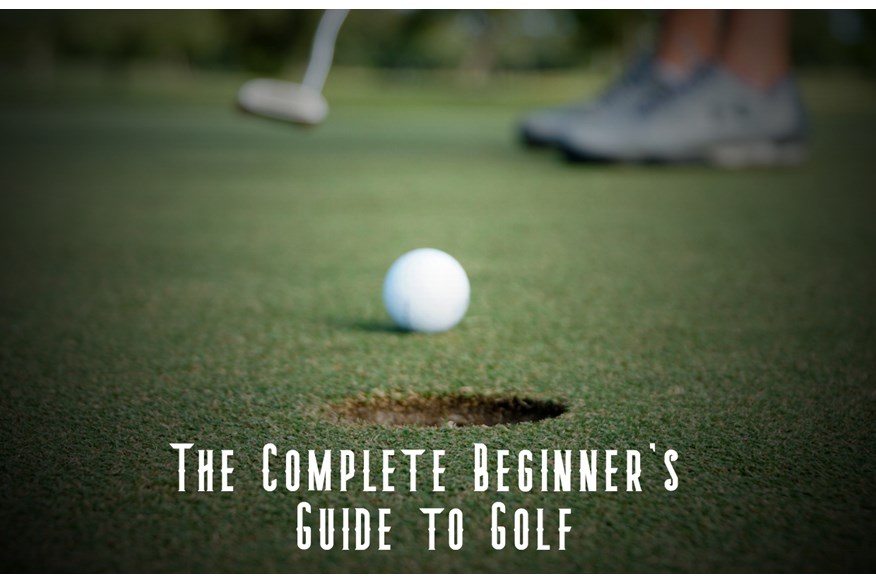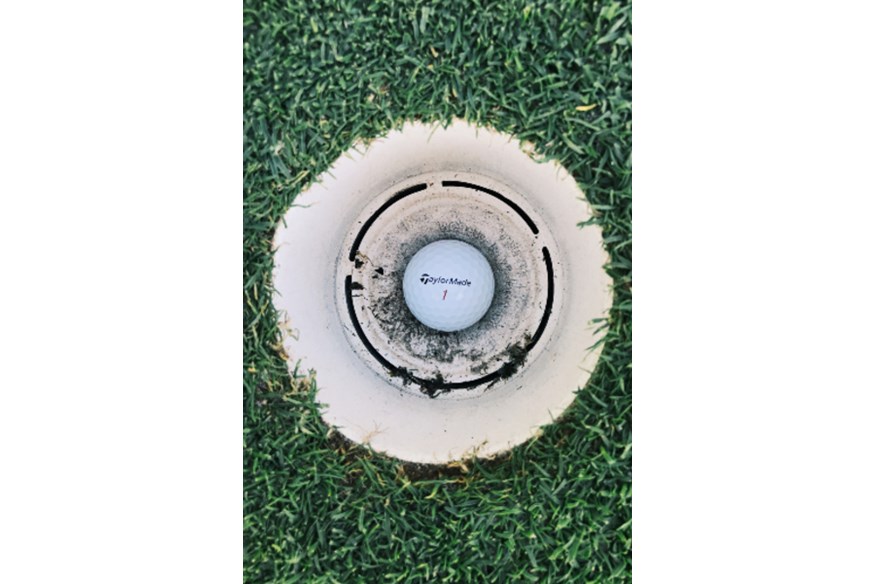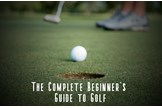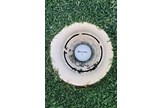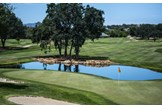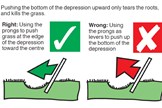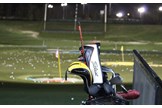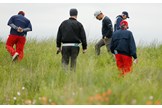The Complete Beginner’s Guide to Golf
Last updated:
Avoid embarrassment and costly mistakes as a beginner with our invaluable guide to becoming a fully fledged golfer.
So you want to take up golf? Good for you, and welcome to a lifelong relationship with a sport (and before you say it, yes, golf is a sport, it’s in the Olympics and everything…) that will bring you joy and despair, highs and lows, new friendships, travel opportunities, life lessons, and much, much more.
But, before all that, we know that you just want to get through the first steps of becoming a golfer without embarrassing yourself or making any expensive mistakes. That’s why we’ve put together this Complete Beginner’s Guide to Golf – covering everything from what to wear, where to play, when to play, what to say, what not to say, the rules you actually need to know, what to spend your money on, what not to waste your money on, and how to avoid getting into a big punch-up on the second green.
We think this guide gives you everything you need to set you on the fast-track to becoming a brilliant and happy golfer without making the mistakes many newcomers do, but if you take only one thing from it, make it this:
Every golfer you see – even the really good ones and the ones with all the flashy gear – they all started out as complete beginners too. Being a beginner golfer is nothing to be ashamed of and no one is judging you. In fact, most experienced golfers will enjoy the opportunity to pass on their wisdom and give you guidance. Enjoy the learning process from the very beginning – including the successes and failures you’ll no doubt experience along the way – and you can already start calling yourself a golfer.
Did you know: Today’s Golfer magazine is full of advice on the best equipment and tips to help your game! Click Now to take advantage of our latest subscription offers
CLUBS
The golf clubs you use certainly aren’t the be-all and end-all, especially at this stage, but you can’t really play golf without them, so it seemed like a good place to start.
Don’t be intimidated by the huge selection of clubs available, and definitely don’t be put off by the hefty price tags on some of them. Yes, you can easily spend thousands on a set of golf clubs, but there’s absolutely no need to do that – and certainly not before you’re even sure if you’re going to stick with it.
When you’re just starting out, you only really need two clubs: a putter and one to hit actual full shots with. If someone you know is willing to donate you a few old clubs, that’s perfect. You just need something to get the ball rolling, so to speak. We hope this goes without saying, but make sure the clubs are right-handed if you are, left-handed if not.
If no one has any clubs to offer you, you’ll need to buy some. The amount you choose to spend will obviously depend on your budget and how certain you are that you won’t give up golf within the first fortnight – you don’t want to splash £2,000 on a full set of brand new clubs if you only end up using them once.
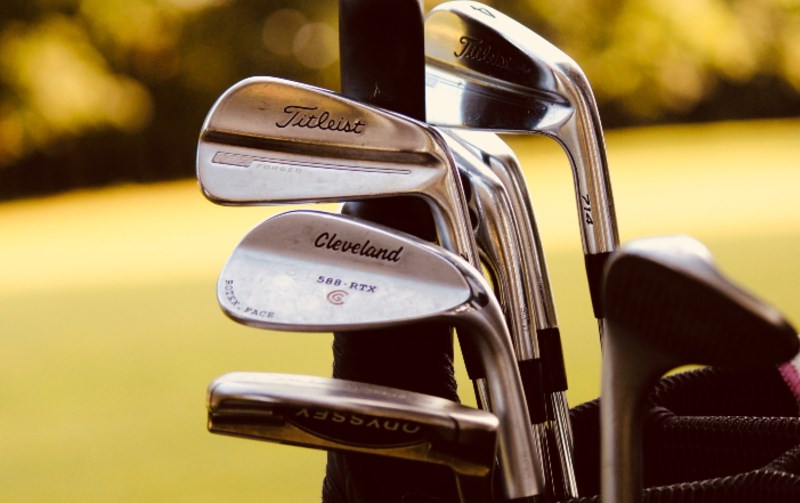
You can get brand new sets from some of the less prestigious brands (they’ll still be perfectly fine for your needs at the moment) quite cheap in places like Sports Direct and American Golf, or second-hand is a great way to go. American Golf sell used equipment, as might the pro shop at your local golf club, or there is an endless choice online. Have a look on eBay or there are numerous Facebook pages dedicated to the sale of used golf equipment. Don’t rush in and buy the first set you see; spend a little time browsing to get an idea of what you can expect to get for your money before bidding on anything.
Related: Best Used Golf Clubs
The maximum number of clubs you’re allowed to carry during a round of golf is 14, but you probably don’t need a full set just yet. You could buy a full-set, of course, and if you’re completely committed to sticking with golf then doing that will mean you’re set for the future, but if you’re just trying it out to see if you like it, our advice would be to buy enough clubs to make what is called a half-set.
Something like a driver, hybrid, 7-iron, pitching wedge and a putter. It doesn’t need to be exactly those; you could take a 6-iron instead of a 7-iron, or a 9-iron instead of the pitching wedge (although if you do that you might want to add a sand wedge as well). If this is all sounding like an incomprehensible foreign language to you, fear not. Here is a handy list of what the different clubs are called and what you use them for:
What are the different golf clubs and what do they do?
Driver – the longest club in your bag (the shaft is normally around 46 inches), with the biggest head. It will be the one you use to tee off (start the hole) on most par-4s and par-5s (more on that in a minute) as it should, in theory, hit the ball further than any of your other clubs. You’ll put your ball on a tee peg to use it.
3-wood – the second-longest club in your bag, used off the tee or for long second shots.
5-wood – like the 3-wood but with more loft, meaning it flies higher but doesn’t go quite as far. You can get all manner of woods, including 7-wood, 9-wood and even an 11-wood, but 3-woods and 5-woods are the most common. Some golfers carry several, whereas some may not have one at all. It all comes down to what works best for you and what you’re comfortable with.
Long irons – anything from a 1-iron to a 4- or 5-iron would typically be classed as a “long iron”. It is what it says on the tin: these are your longest irons in terms of their physical length, but also what they offer in terms of shot distance. They are generally the hardest to hit – 1-, 2- and 3-irons are increasingly rare these days – which is why many golfers favour hybrids instead.
Hybrids – offering a happy medium between woods and irons, many golfers favour hybrids as they are typically easier to get airborne than long irons.
Mid-irons – from 5- or 6-iron down to about a 9-iron (there’s no official cutoff point) are what would be classed as mid-irons. Ideally, each iron in your bag will go about 10-15 yards longer than the one below it, but don’t worry too much about that when you’re starting out as you might find some of them are going pretty similar distances. That will change as you improve and can strike the ball more consistently.
Short irons and wedges – there are four types of wedges, each with a different amount of loft to help you hit the ball different distances, although some golfers like to use one wedge for all of their short shots and get creative to make it go as far as they need it to.
Pitching wedge: coming in just after your 9-iron, this is often used for full shots but can also be used for pitch shots and little chips around the green.
Gap wedge: plugging the gap between your pitching wedge and sand wedge. Don’t be alarmed if you don’t have one of these at this stage.
Sand wedge: commonly used, as the name would suggest, from the sand, but can be used anywhere and for any short shot you fancy.
Lob wedge: the most lofted club in the bag. Not all golfers carry one, but many do, as they like using it to get out of deep bunkers or to play approach shots that fly high and stop quickly upon landing. Can be quite hard to hit full shots with, but great fun to use around the green.
Putter – arguably the most important club in your bag, as you will use it far more than any other club. There are countless different types, designs and models, but the basic choice is between a “blade” and “mallet”. Blades are fairly slim (like the traditional shape you’d get at mini golf) whereas mallets are – you guessed it – more mallet-like. It all comes down to personal preference and what suits your eye. Most big golf shops will have a range for you to try out, so hit some putts with as many different styles as you can and see what you like best.
OTHER BITS YOU NEED
Golf bag – If you’re just going to the range or a little pitch & putt course, you don’t need one, but as soon as you start carrying more than two clubs or going on an actual golf course, it’s a must. You’ll be able to pick up a cheap one online or a second-hand one from a charity shop or boot sale; just make sure it’s got a double-strap (far more comfortable), no big rips or tears, and that the legs work.
Towel – It clips onto your bag and is handy for giving your club a quick wipe after each shot to keep it clean. Also good for absorbing tears if you’re really having a tough time out there.
Golf balls – By all means, buy the ones that cost £45 a box because your favourite tour pro uses them if you wish, but bear in mind that works out at nearly £4 a ball. In your early rounds of golf, you’ll probably be losing balls hand over fist, so that gets pretty expensive pretty quickly. You can get perfectly good balls for about half that, especially if you shop around a bit. We’d recommend the Srixon AD333 or Mizuno JPX as they perform well and won’t break the bank. You can buy used balls, often called “lake balls”, but you never really know what you’re getting and the quality can be a bit hit and miss.

Tee pegs – Golf snobs will insist on wooden ones but plastic ones last longer and help you tee your ball at the same height every time, which gives you one less thing to worry about.
Pitchmark repairer – At some stage, you’ll hit a beautiful shot that flies high into the sky and lands on the green with a thud. It’s a moment to rejoice, but you’ll also notice that your ball’s landing has created a little dent in the putting surface. You’ll want to repair that (we’ll show you how later) and a pitchmark repairer is the tool for the job.
Ball marker – When your ball is on the green, you are allowed to put a marker down behind it (on a direct line away from the hole), enabling you to pick up your ball to clean it and, if you wish, line it up. Technically you can use any object to do that – tee peg, coin, mobile phone, saucepan – but a ball marker is an inexpensive way to make yourself look like a real golfer. It’s also small and light, which means it’s no effort to carry in your pocket and won’t get in the way of any of your playing partners when they hit a putt on the green (which can’t be said of a saucepan).
Sharpie – Your balls will have the brand and model written on there, as well as a number, but you might not be the only person on the course playing a Srixon AD333 number 1. It’s therefore a good idea to put an individual marking on your ball to avoid any doubt over whose is whose.
GPS or laser – Certainly not essential at the start, but most regular golfers nowadays have a device that tells them the exact distance to the flag so they know how far they need to hit their next shot. There are two main types: a GPS which typically comes in the form of a watch or a small handheld device, or a laser which you aim at your target. Again, it’s personal preference, so speak to some golfers you know about what they use or check out some of our GPS and laser rangefinder reviews to get an idea of the benefits of each.
CLOTHING
What to wear to the driving range
If you’re just going to a standalone driving range, you can normally wear pretty much anything. Jeans, sports shorts, tracksuit bottoms are all fine and dandy. If you are going to a driving range that is part of a golf club, however, the club’s normal dress code will often apply. This is usually covered on the club’s website or you can always call and ask the pro shop if you’re not sure.
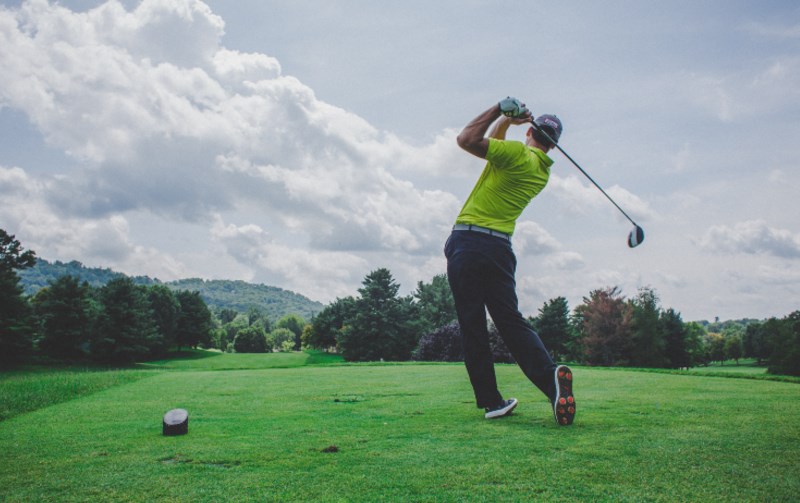
What to wear on the golf course
The dress code varies significantly from one golf club to the next, so it’s always a good idea to check online or ring and check before turning up if you’re not sure. Some clubs are very relaxed and allow jeans and t-shirts, while others will want you to wear a collared shirt and can even be funny about the length of your socks.
If you’re ever unsure and want to play it safe – or just look the part – you won’t go far wrong with a collared polo shirt (avoid football shirts or anything with a huge logo across the chest) and a pair of trousers (chinos are always fine, jeans and tracksuit bottoms are often a no-no).
In terms of footwear, at many courses you will get away with trainers, particularly as many modern golf shoes look like trainers anyway, but some places may insist on golf shoes. Golf shoes will offer you better grip than trainers, anyway, so it’s worth getting a pair. You can pick up a perfectly decent pair for under £40 – top-end pairs can be over £200.
So, you’ve now got all your gear sorted, but what are you meant to do with it?
THE DIFFERENT TYPES OF GOLF SHOTS
Now you’ve got your clubs sorted, you want to know what you can do with them (other than stare at them lovingly/swear at them when they don’t do what you want). If you’ve watched much golf on television or ever played a golf computer game, you’ll have a decent understanding of the different shot types and what they’re called. If not, here’s a handy breakdown:

Full-shot – A normal swing that gives you the full distance from whatever club you’re hitting.
Half-shot – Don’t focus too much on the term “half”, as really this just means any shot where you deliberately hit a club a bit shorter than it would normally go.
Punch shot – A shot where you deliberately keep the ball lower than normal, either because it’s windy or because you have some tree branches to go under. If there are trees where you play, expect to be playing this shot a lot in your first few rounds!
Pitch shot – A controlled shot, typically from 100 yards or less, designed to send the ball in the air and stop relatively quickly once it reaches the green.
Chip shot – An alternative to a pitch shot, the main difference being that the ball will fly lower, but therefore bounce and roll more once it lands. Can be done with any of your irons, but most golfers will use something between a 7-iron and their lob wedge for chip shots. The less loft you have, the lower the ball will fly and the more it will roll.
Flop shot – Normally done with the most lofted club in your bag, the flop shot flies very high and stops very quickly when it lands. A high-risk shot that is rarely needed but sometimes used to get over an obstacle, they are impressive if you can pull them off.
Fade – Any shot that curves from left-to-right in the air (reverse for left-handers) would be classed as a fade.
Slice – A more severe left-to-right curvature would be called a slice, particularly if it curves too much and misses your target to the right. The slice is a problem many golfers struggle with, not just beginners.
Draw – A shot that curves right-to-left in the air (reverse for left-handers).
Hook – A more aggressive curvature, particularly one that misses your target to the left, would be called a hook.
Putt – any shot hit with your putter. The majority of these will be on the green, but there’s nothing wrong with putting from just off in – in fact, many golfers get better results that way than chipping.
GOLF LESSONS
Getting golf lessons right at the start is a brilliant idea and will save you a lot of problems in the future trying to fix bad habits you’ve picked up and ingrained over time.
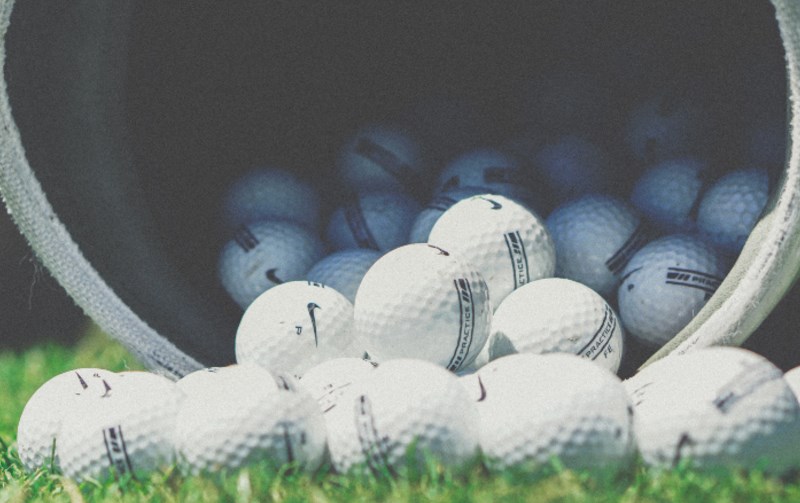
Many clubs offer “get into golf” packages for beginners, so ask around or have a Google to see if there’s anything like that in your area. If money is tight, group lessons can be a good way to get some time with a coach. One-to-one sessions are great, but as you’ll be covering the basics, you won’t lose much by doing it as part of a group, and you’ll get the additional benefit of meeting other beginner golfers.
PRACTICE
Ideally you’ll be having a group lesson every week or at least every couple of weeks, but if you want to speed up your progress, it’s a good idea to practise in between. The driving range is a good place to do that as it’s cheaper and quicker than playing a full round of golf – plus there’s no stress about hitting bad shots, missing the ball, holding up the people behind you, etc.
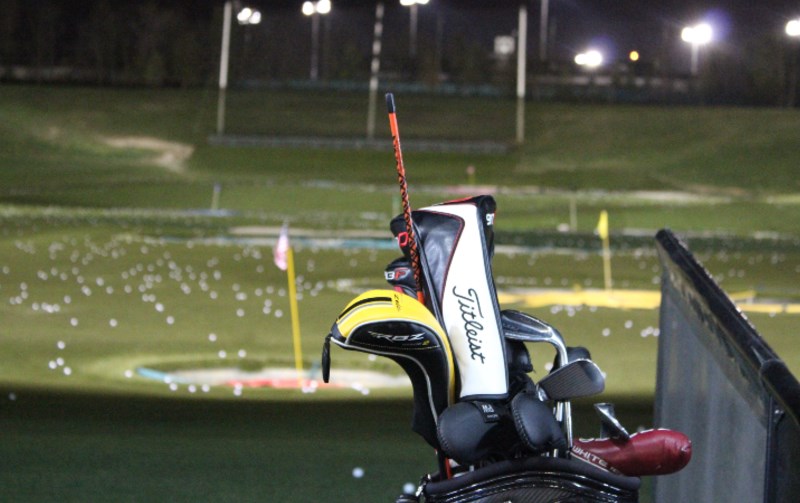
If you can find a driving range that has a short game area, that’s even better, as practicing your chipping and putting is the fastest way to help yourself score better when you’re on the golf course.
YOUR FIRST TIME ON THE COURSE
Your first proper round of golf is a very exciting experience – but it can also be a daunting one. There are so many things to worry about – am I good enough to even be on the course? Will people be laughing at my three air-shots on the first tee? Where do I stand? What does that sign mean? – and the last thing you want is for your first taste of proper golf to be an unenjoyable one.
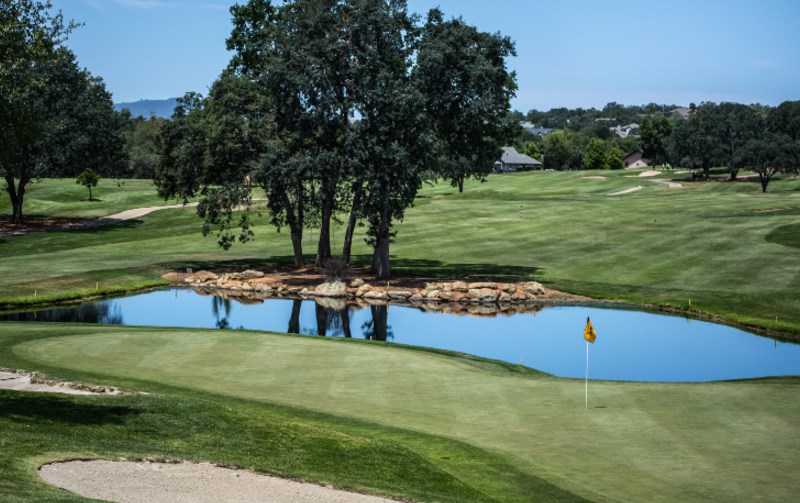
The easiest way to reduce this stress is to pick the right course – and the right time to play. Teeing off on a Saturday morning at a busy, upmarket club is like taking your first driving lesson at rush hour on the M25. Late afternoons and evenings tend to be far quieter at most golf clubs, meaning you’ll have time to do what you need to do without worrying about causing a traffic jam behind you. And don’t jump in at the deep end by going to the most expensive and highly rated course in your area. It will probably be too difficult and you won’t enjoy it. Cheaper, less formal, municipal (pay-and-play) courses are generally a much better place to start. As an added bonus, they tend to be slightly less challenging than the more prestigious clubs, which you’ll be grateful of when you’re still honing your skills.
Alternatively, if there’s a par-3 course in your area, that’s a great place to get your first taste of being on the course.
Keeping people happy
Remember when you were learning to drive, the most stressful thing was worrying about upsetting (or enraging) other drivers? Most beginners feel like that the first time they go on the golf course, but don’t worry. It’s easy to keep fellow golfers – including those in your group and other people on the course at the same time – happy, just by common sense and a feel simple common courtesies:
Avoid slow play
One thing you’ll realise is that golfers love playing golf, but most of them want it to be over as quickly as possible. Slow play is the quickest way to rile your fellow golfers, and it can feel unavoidable when you’re a beginner and therefore taking far more shots than more accomplished players.
No one is expecting you to rush your shots, especially as doing so will normally generate worse results, making matters worse. Allow yourself time to plan the shot you’re going to hit, take a practice swing and then hit your shot. Some of that can be done while you’re waiting for other people in your group to play, provided you’re not doing anything that would distract the person whose turn it is to hit. Speaking of which…
What order do we play in?
Typically, whoever got the best score on the previous hole will tee off first on the next one, although most clubs (and golfers) now advocate “ready golf”, meaning whoever is ready goes, regardless of previous scores.
Aside from tee shots, whoever is furthest from the hole will play first – again this can sometimes be negated in favour of “ready golf”.
What if I’m having a nightmare hole?
If you’ve had 13 swipes, lost three balls and still haven’t made it halfway to the green, there’s nothing wrong with picking up your ball and saying you’ll sit out the rest of this hole. You might set yourself a limit – maybe eight or 10 shots – after which you’ll pick up and move on. It’s a great way to keep things moving and there’s little point in beating yourself up when things have gone against you on a given hole. Take the a few minutes’ grace while your playing partners finish the hole to regroup and be ready to go again on the next tee.
Shout “fore”
If you hear a shout of “fore” when you’re on the course, do whatever you can to protect your head by adopting something like the brace position. It’s a way of golfers warning others that a stray shot is heading in their direction. It’s vital, therefore, that you shout “fore” if you hit a shot that is going anywhere near another player. Even if you can’t see exactly where your ball has gone, or you it’s not going to hit anyone, it’s always better to be safe than sorry. No golfer ever got upset about an unnecessary warning, but if you hit someone without even giving them a chance to protect themselves, they will understandably be less than impressed.

Take care of the course
We mentioned repairing pitchmarks on the green earlier. Here’s the best way to do it:
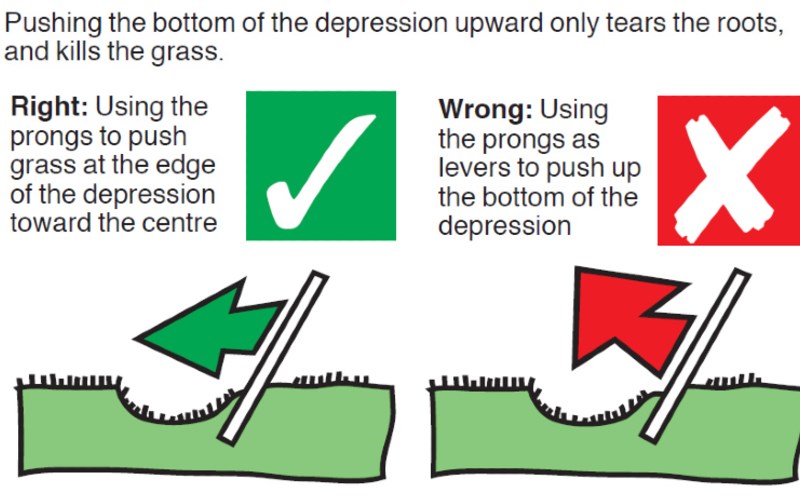
There are a few other things you should always do to keep the course in good condition. In essence, it’s about leaving things as you found them. If you take a divot (don’t worry, that’s perfectly normal), pick up the chunk of turf and replace it. The only place this doesn’t apply is on the tee box, where there will often be a tub of seed to use instead. If you go in a bunker, make sure you rake it on your way out so there’s no evidence of you having been in there.
Being a good playing partner
You’ll pick things up as you go by watching others, but the basic idea is to not get in anyone’s way or put anyone off their game. It’s common courtesy to stop talking when someone is about to hit a shot, to avoid walking across the line of where someone is about to hit a putt (i.e. stepping where their ball may roll) and to keep an eye on where their ball has gone in case they lose sight of it.
THE RULES OF GOLF (THE ONES YOU ACTUALLY NEED TO KNOW)
Like most sports, golf does have an extensive rule book designed to cover every possible eventuality, but there’s no need to worry about that when you’re a beginner. In truth, even experienced golfers couldn’t correctly explain half of them.
Keep count
One of the quickest ways to upset people is by claiming a score at the end of a hole lower than the number of shots you actually took. It sounds simple, but when you’re taking a lot of shots (and some of them might only be traveling a few yards) it can be easy to forget one or two. Do your best to remember each one and if you’re ever unsure, be honest and try to count back through them. One of your playing partners will normally be able to help jog your memory about a shot you’ve forgotten – especially if you’re playing them for a fiver!
Play it as it lies
If your ball is on the putting green, you’re entitled to mark it to clean it, and then put it back in exactly the same spot. Everywhere else, you have to play your ball as it lies. If that means there’s some really long grass behind it, it’s tough luck. You can’t try to improve your lie by trampling down the grass around your ball, pulling it out like an overzealous Alan Titchmarsh or whacking away at it with your club.
Only look for three minutes
You’re only allowed three minutes to search for your ball (the time starts when you get to the vicinity you think it’s in). People don’t tend to time it, but if you’ve had a good look and there’s no sign of it, it’s probably time to accept it’s a goner. If your playing partners start walking off and saying things like, “Oh well, looks like you’ve lost that one” – that’s a hint they think it’s time to move on.
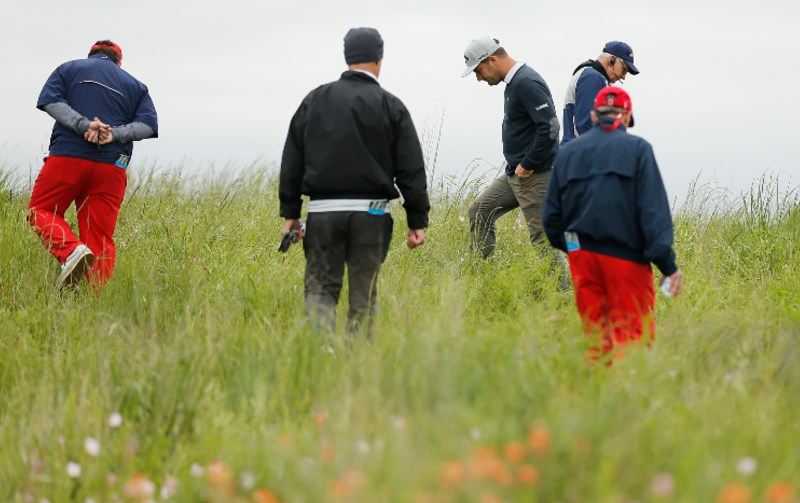
Play a provisional
If you hit a shot somewhere that you think will make it hard to find (think long grass, in the trees, middle of a lake, etc) it’s a good idea to hit a provisional. This basically means playing another ball from the same spot, which will become your ball in play if you can’t find the first one. You will incur a penalty (it costs you a one-shot penalty, plus the extra shot you hit – so you’d effectively be hitting your third shot from the tee) but it’s far preferable to looking for your original ball first and then having to walk back and hit another one.
If you’re just playing for fun, your group might decide to adopt an informal rule where you can drop a ball roughly where you think your lost one would have been and just add a one-shot penalty from there. It’s a good way to keep things moving but remember that you won’t be able to do that once you start playing competitions or rounds that count towards your handicap.
MAKING SENSE OF THE SCORECARD

You won’t be playing official competitions at the start, so don’t worry about all the finer intricacies of filling out your card correctly, but it’s full of information that can help you.
Names – There is space at the top to write the name of the person filling out the card (the “marker) and up to three of their playing partners. That means one of you can do the job for your group of four, saving some time. If and when you start playing official competitions, you’ll need a card each, but don’t worry about that for now.
Yardages – Alongside each hole you’ll see a yardage number or, in many cases, several yardage numbers. This is to cover the different set of tees you might be playing from (white tees are typically a bit further back than yellow tees), so make sure you’re looking at the right ones. Most courses will have a sign by the tee giving you this information as well.
Par – The number of shots it should take you to complete the hole. Don’t panic! No one is expecting you to make a par on every hole at this stage. In fact, don’t be surprised if it takes you weeks or months to make your first par. Par is a relative term anyway. If you have a handicap of 36, for instance, a par-4 would actually be a par-6 for you.
Stroke index – You won’t have an official handicap at the beginning (we’ll cover the process of getting one later) but many golfers like to play with an unofficial one to give themselves something to focus on. It’s a good idea. Give yourself a handicap of 54 to start with and go with that until you find that’s making things too easy. The stroke index is basically a ranking of how difficult the holes are on the course. So stroke index 1 is the hardest hole on the course, stroke index 18 the easiest. Playing off 54, you’ll get three extra shots on every hole, which makes it nice and simple, but later on the stroke index is used to determine where you get your shots. If you play off nine, for example, you would get a shot on the nine hardest holes, but nothing on the easiest nine. If you’re off 24, you would get two shots on the six hardest holes, and one on the rest.
Speaking of which…
GETTING A HANDICAP
Once you’ve been playing for a while, you’ll probably want to get an official handicap. This entitles you to play in competitions, and some clubs (though not many nowadays) won’t even let you play as a visitor without one.
To get a handicap, you’ll need to be a member of a club, and then you just need to submit three completed scorecards. The scorecards need to be marked and signed by someone else, usually another member.
Related: Golf’s new World Handicap System
By the time you are a member of a club, have an official handicap and start playing in competitions, we’re no longer considering you a beginner. You’ve done it! Just remember us when you win the Masters in a few years’ time…
Golf Formats
There are several different formats that you can play when golfing, depending on whether you are playing by yourself or with others.
The most common is strokeplay, which is played by an individual for the majority of medals, competitions and in every professional tournament. However, there are also other formats where the scoring is different, including stableford, match play and foursomes. Here’s what you need to know.
Strokeplay:
Also known as Medal Play, Stroke Play involves an individual counting the total number of strokes they have taken on each hole during a given round, or series of rounds. The winner is the player who has taken the fewest number of strokes over the course of the round, or rounds.
Stableford:
In this type of competition points are awarded depending on the score for each hole. It was designed to speed up play – as soon as a player can no longer score a point he can pick up his ball.
A player scores one point for a nett (minus their handicap) bogey, two for par, three for a birdie, four for an eagle and five for an albatross. You win a competition by scoring the most points overall.
Example: On an amateur level, if a player takes six shots on a par-four hole but is entitled to a shot because of his handicap, his net score is five.
Match Play:
Match play scoring consists of individual holes won, halved or lost. On each hole, the most that can be gained is one point. Golfers play as normal, counting the strokes taken on a given hole. The golfer with the lowest score on a given hole receives one point. If the golfers tie, then the hole is halved.
Better Ball:
Better Ball is used in match play competitions, consists of two teams of two golf players competing directly against each other. Each golfer plays his or her own ball throughout the round, such that four balls are in play. A team’s number of strokes for a given hole is that of the lower scoring team member.
Foursomes:
Golfers compete in teams of two, each using one ball, and taking alternate shots until the hole is completed. Team members also take turns in teeing off on each hole, i.e. one player will take the tee shot on odd-numbered holes, and the other on even-numbered holes. Foursomes is commonly played as match play, with each hole being won by the team that completes it in the fewest shots. This form of golf is often played in team golf competitions such as the Ryder Cup, Solheim Cup, Seve Trophy and the Presidents Cup. Foursomes can also be played in stroke play competitions, with the winners being the team who have taken the fewest number of strokes to complete a set number of holes.
Scramble:
Each player in a team tees off on each hole, and the players decide which shot was best. Every player then plays their second shot from within a clublength of where the best shot has come to rest (and no closer to the hole), and the procedure is repeated until the hole is finished. This system is very common at informal tournaments such as for charity, as it speeds play (due to the reduced number of shots taken from bad lies), allows teams of varying sizes, and allows players of widely varying skill levels to participate without a profoundly negative impact on team score.
READ NEXT: Meet the comedians who are making ‘Bad Golf’ hilarious and accessible
